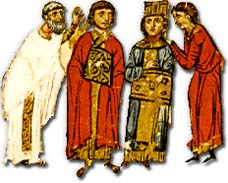Emperors also had a lot of "free" time beside official activities.
As we have mentioned, rulers were very religious persons. In a Great
Palace, where lots of churches were situated, the Holy Service never
ended. Some of the rulers enjoyed singing with the choir, like Leo
the Armenian. Some of them used to conduct the choir like Theofil
who also composed hymns. Some of them used to live ascetic life like
Nikiforos Fucca and Michael
IV .
 As
the most educated persons, emperors were writers, musicians, historians,
and great spokesmen. Some of the rulers used to simply read late at
night like Theodosios II
who also enjoyed painting and writing.
As
the most educated persons, emperors were writers, musicians, historians,
and great spokesmen. Some of the rulers used to simply read late at
night like Theodosios II
who also enjoyed painting and writing.
Constantine Porphirogenite
(Ο Κωνσταντινός ο Πορφυρογέννιτός) also enjoyed such things, but he
was much more gifted. He was a famous painter, jeweler, sculptor, musician,
and he knew mechanics. He was also historian, archeologist, and encyclopedist.
That's interesting, but he ignited the research of Byzantology, being also the subject of its research today.
However, some of the rulers enjoyed gambling. Some of them were so
passionate by gambling that they neglected their duty of an Emperor
badly, like Constantine VIII.
During rule of Theodosios
II, a game called τσικανιστέριον became popular in the
City. That was today's polo. It's interesting that it came from Persia where it is still being played.
Special stadiums just for this game existed in Trapezount and Efesus.
Also, horse racing was very popular part of life for all the citizens
of Constantinople and also for emperors. Some of them used to participate
in such races, like Michael III.
Hunting was also one of the favourite hobbies of rulers. Michael III,
Vasilios I, Roman II, Isaac Comnenus were all passionate hunters. Park
Φηλοπάτιον near the City was surrounded by walls just for hunting. Typical
hunting tools were arrows and lance.
Emperors owned several residences all around the country. Some of those
were very famous buildings like the Silver Lake at the Golden Horn
in the suburb of Constantinople, Χεβδομόν at sea of Marmara, then at Chalkedon,
Chierea, (where council of iconoclasts took place in 754). Rulers also
used to visit thermal springs at Olympia in Little Asia. Justinian erected
several baths over there and they have been in use until the 10th century.